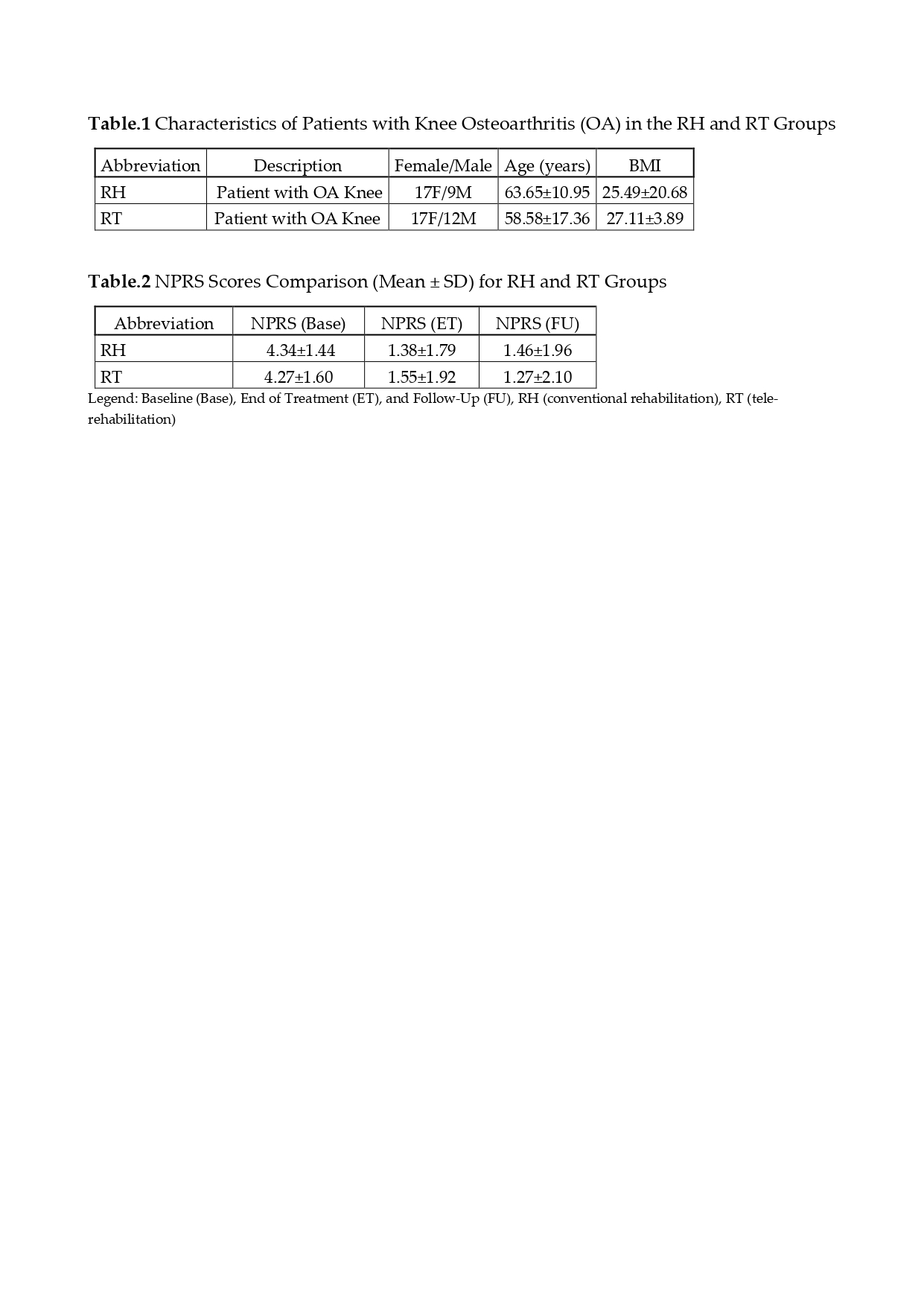Teleriabilitazione per l’osteoartrosi del ginocchio: Valutazione dell’efficacia, dell’aderenza e degli esiti del paziente
Tele-Rehabilitation for Knee Osteoarthritis: Evaluating Efficacy, Compliance, and Patient Outcomes
Introduction
The COVID-19 pandemic has brought significant challenges to the healthcare system, including the care of individuals with osteoarthritis (OA)[ 1 ]. Tele-rehabilitation (TR) has emerged as a valuable tool for managing OA through remote exercise interventions, offering potential benefits in reducing costs. This study aims to evaluate the efficacy of TR in managing knee OA, hypothesizing that evidence-based exercise programs delivered through TR can achieve comparable outcomes to traditional clinic-based interventions while potentially reducing overall healthcare costs. By improving adherence and providing a familiar, protected environment for patients, TR has the potential to enhance chronic disease management and quality of life while also offering cost-saving advantages. Understanding the effectiveness of TR in OA care can inform decision-making and help optimize healthcare resources in the post-pandemic era.
Methods
This randomized controlled trial included 50 participants with knee osteoarthritis. They were randomly assigned to either the experimental or control group (25 participants each). Both groups performed the same exercise interventions, including seated knee exercises, isometric quadriceps exercises, sit-to-stand exercises, and wall squats [ 2 ][ 3 ]. The intervention consisted of 12 sessions, three times a week. In the experimental group, participants received home-based rehabilitation through tele-rehabilitation supervised by a dedicated physiotherapist. The control group received conventional rehabilitation at the institute, also supervised by a dedicated physiotherapist. Assessments were conducted at baseline, post-treatment, and at a 1-month follow-up, measuring pain reduction using the Numeric Pain Rating Scale (NRPS)[ 4 ] and secondary outcomes.
Results
In the independent samples t-tests, conducted to compare the two groups, the results showed the following: At the Baseline assessment, there was no statistically significant difference between the groups in terms of NPRS scores (t = 0.170, df = 53, p = 0.865), with a mean difference of 0.070 (SE = 0.413, Cohen’s d = 0.046). Similarly, at the End of Treatment assessment, no significant difference was found in NPRS scores between the groups (t = -0.333, df = 53, p = 0.741), with a mean difference of -0.167 (SE = 0.502, Cohen’s d = -0.090). The results at the After 3-month assessment also revealed no significant difference between the groups in terms of NPRS scores (t = 0.337, df = 53, p = 0.737), with a mean difference of 0.186 (SE = 0.551, Cohen’s d = 0.091). These findings suggest that there were no significant differences in pain levels between the two groups at any of the assessment points.
Discussion and Conclusion
This study compared the effectiveness of home-based tele-rehabilitation and hospital-based rehabilitation in reducing knee osteoarthritis-related pain. Both groups showed significant pain improvement after one month of targeted exercises. No significant difference was found between the groups, indicating that home-based tele-rehabilitation was as effective as hospital-based rehabilitation. Pain improvement was sustained at the three-month follow-up. These findings suggest that home-based tele-rehabilitation can be a viable alternative to hospital-based rehabilitation, improving accessibility and convenience. In conclusion, both treatment modalities effectively reduce knee osteoarthritis-related pain, with home-based tele-rehabilitation offering comparable benefits and the potential to revolutionize care delivery.
REFERENCES
[ 1 ] Ragni, E., Mangiavini, L., Viganò, M., Brini, A.T., Peretti, G.M., Banfi, G., de Girolamo, L., 2020. Management of Osteoarthritis During the COVID‐19 Pandemic. Clin Pharmacol Ther 108, 719–729. https://doi.org/10.1002/cpt.1910
[ 2 ] Janssen, W.G.M., Bussmann, H.B.J., Stam, H.J., 2002. Determinants of the sit-to-stand movement: a review. Phys Ther 82, 866–879.
[ 3 ] Skou, S.T., Pedersen, B.K., Abbott, J.H., Patterson, B., Barton, C., 2018. Physical Activity and Exercise Therapy Benefit More Than Just Symptoms and Impairments in People With Hip and Knee Osteoarthritis. J Orthop Sports Phys Ther 48, 439–447. https://doi.org/10.2519/jospt.2018.7877
[ 4 ] Childs, J.D., Piva, S.R., Fritz, J.M., 2005. Responsiveness of the numeric pain rating scale in patients with low back pain. Spine (Phila Pa 1976) 30, 1331–1334. https://doi.org/10.1097/01.brs.0000164099.92112.29

